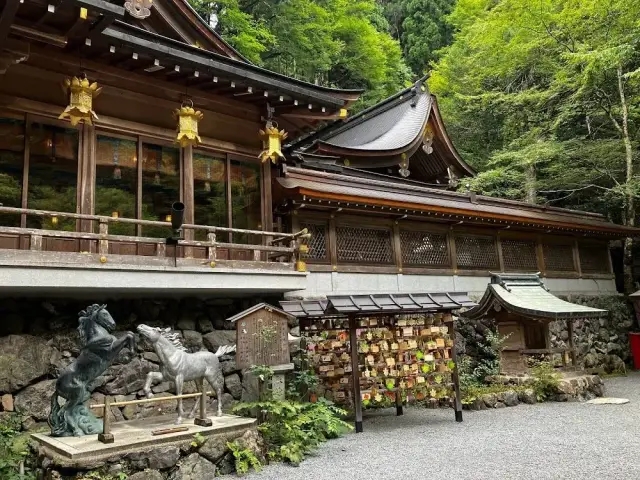https://www.dekitabi.com/itinerary/kyoto-day-trip-mount-kurama
Nestled in the serene mountains north of Kyoto, Kifune Shrine, Kurama-dera Temple, and Mount Kurama offer a captivating blend of spiritual heritage and natural beauty. For travelers seeking an authentic and tranquil Japanese experience, these sites promise an unforgettable journey into the heart of traditional Kyoto.
Kifune Shrine: A Sacred Retreat

https://www.dekitabi.com/attraction/kifune-jinja-shrine
Kifune Shrine, located in the charming town of Kibune, is renowned for its picturesque setting and spiritual significance. Dedicated to the deity of water, the shrine has been a pilgrimage site for centuries, attracting visitors seeking blessings for safe travel, fertility, and prosperous business. The shrine’s unique location along the Kifune River enhances its mystical atmosphere, especially during the summer when lanterns illuminate the pathway, creating a magical scene.
The approach to Kifune Shrine is a beautiful journey in itself. Visitors walk along a stone path flanked by lush greenery, leading to the shrine’s main hall. The torii gates, adorned with vibrant red hues, mark the entrance to this sacred space. The highlight of Kifune Shrine is the “Kifune Water Festival” held annually in early June, where locals celebrate with traditional music and dance, adding to the shrine’s vibrant cultural tapestry.
Kurama-dera Temple: Embracing Tranquility and Tradition

https://www.dekitabi.com/attraction/kurama-dera-temple
A short distance from Kifune Shrine lies Kurama-dera Temple, a revered Buddhist site steeped in history and tradition. Founded in the 8th century by the renowned monk Saicho, Kurama-dera Temple is dedicated to the deity of healing and enlightenment. The temple’s location on Mount Kurama provides a serene backdrop for meditation and reflection, making it a perfect retreat from the bustling city life of Kyoto.
Visitors to Kurama-dera Temple are greeted by a series of stone steps that lead up to the temple complex. The climb, surrounded by ancient trees and the soothing sounds of nature, sets the stage for a spiritually enriching experience. The temple’s main hall, with its traditional wooden architecture and stunning views of the surrounding mountains, offers a peaceful sanctuary for those seeking solace.
Kurama-dera Temple is also known for its association with the practice of “Kannon Shugyo,” a form of ascetic training. The temple hosts various workshops and ceremonies throughout the year, providing visitors with the opportunity to engage in traditional Japanese spiritual practices.
Mount Kurama: A Journey Through Nature and Legend

https://www.dekitabi.com/attraction/mt-kurama
Mount Kurama, often referred to as the spiritual heart of the region, is a haven for nature enthusiasts and spiritual seekers alike. This sacred mountain is intertwined with Japanese folklore and is believed to be the home of ancient deities and mystical creatures. Hiking trails crisscross the mountain, offering breathtaking views of the surrounding landscapes and a chance to connect with nature on a profound level.
The most popular trail leads from Kurama Village to the summit of Mount Kurama, passing through lush forests, babbling brooks, and ancient shrines along the way. The hike is a rewarding experience, with panoramic views of Kyoto and the opportunity to encounter various spiritual landmarks. Along the trail, visitors can find small shrines and stone markers that reflect the mountain’s deep spiritual significance.
At the top of Mount Kurama, the panoramic vista is a perfect spot for contemplation and appreciation of the natural beauty that surrounds you. The area also features the “Kannon-do,” a small temple dedicated to Kannon, the Buddhist goddess of mercy, offering a tranquil space for meditation and prayer.
Experiencing Kyoto’s Spiritual Heart
Kifune Shrine, Kurama-dera Temple, and Mount Kurama each offer a unique glimpse into Kyoto’s spiritual and natural heritage. These sites are not only important cultural landmarks but also provide a serene escape from the urban environment. Whether you are seeking spiritual enlightenment, a connection with nature, or a deeper understanding of Japanese traditions, this trio of destinations promises a memorable and enriching experience.
Exploring these sacred sites allows visitors to immerse themselves in the timeless beauty and spiritual depth of Kyoto. Each location holds its own stories and traditions, offering a journey that is both educational and inspiring. For those looking to uncover Kyoto’s hidden gems, Kifune Shrine, Kurama-dera Temple, and Mount Kurama are must-visit destinations that embody the essence of Japan’s rich cultural and spiritual heritage.


Leave a Reply